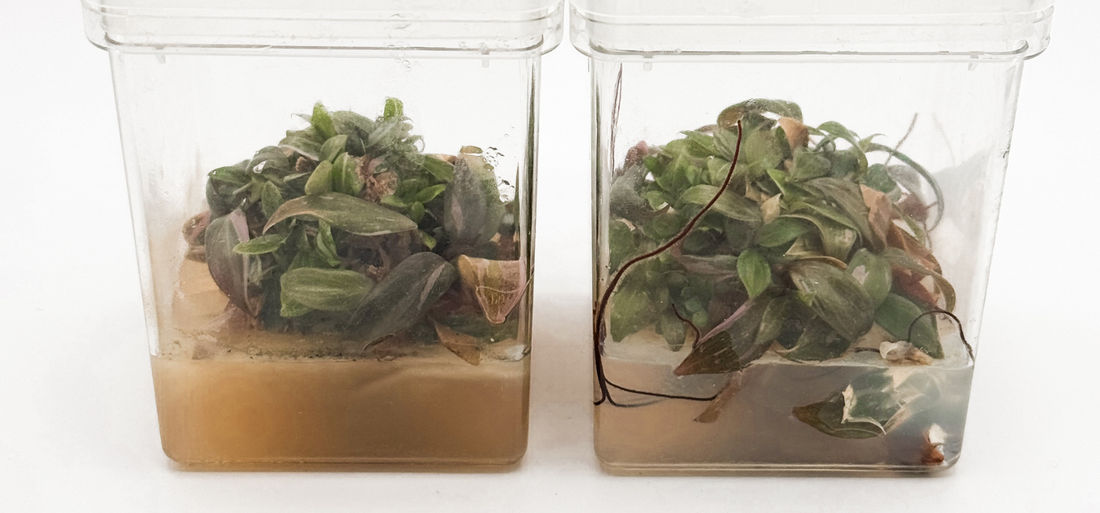
How to Troubleshoot Contamination and Browning in Plant Cultures
As a content and community manager, I leverage my expertise in plant biotechnology, passion for tissue culture, and writing skills to create compelling articles, simplifying intricate scientific concepts, and address your inquiries. As a dedicated science communicator, I strive to spark curiosity and foster a love for science in my audience.


Introduction
Plant tissue culture is a cornerstone of modern botany, enabling everything from the rapid propagation of elite crop varieties to the conservation of endangered species.
However, the very conditions that make this technology so powerful—a nutrient-rich, controlled environment—also create a perfect breeding ground for two persistent and costly problems: microbial contamination and oxidative browning.
These challenges can devastate experiments, compromise valuable germplasm, and bring commercial production to a grinding halt.
While a sterile workspace is the first line of defence, it isn't always enough. Microbes can hide deep within plant tissues, and the stress of culture initiation can cause some plants to release toxic compounds that kill the explant from the inside out.
This is where a strategic understanding of media additives becomes essential.
This guide provides a detailed framework for diagnosing and managing both contamination and browning, transforming these common laboratory frustrations into solvable challenges.
By learning to identify the enemy and deploy the right tools, you can significantly increase your success rate and unlock the full potential of your tissue culture work.

Diagnosis and Management of Microbial Contamination
Microbial contamination is a relentless threat in any tissue culture lab. An invisible invader can turn a promising culture into a lost cause overnight.
The key to effective management lies in accurate identification and a targeted response, using chemical additives as a crucial secondary line of defence against these microscopic saboteurs.
Identifying Common Contaminants
The first step in any battle is to know your enemy. Bacteria, fungi, and yeasts each have unique signatures, and recognizing them allows for a precise, effective response.
-
Bacteria: The most common culprits, bacteria often reveal themselves by making liquid media cloudy or turbid. On solid agar, they form a slimy, glistening film, usually starting at the base of the plant explant. As they multiply, their waste products can lower the medium's pH, causing a pH indicator dye to change colour (e.g., from pink to yellow), a clear sign of a significant infection.
-
Fungi: Fungal contamination is usually more obvious, appearing as fuzzy, cottony, or thread-like growths (mycelium) on the medium or plant. As the fungus matures, it may produce coloured spores—green or blue for Penicillium, black for Aspergillus—which pose a high risk of spreading to other cultures.
-
Yeast: Yeasts can be more subtle, initially appearing as small, round, shiny, or dull colonies that don't immediately alter the medium. However, they grow rapidly and can quickly overwhelm a culture.
-
Endophytic and Cryptic Contaminants: The most challenging invaders are those that live inside the plant tissue (endophytes). They are protected from surface sterilization and may only emerge days or weeks after culture initiation, often triggered by stress. This makes a purely preventative aseptic technique insufficient for some plant species, necessitating the use of systemic biocides in the initial culture medium.
Prophylactic Strategies: The First Line of Defense

Chemical additives are a safety net, not a substitute for rigorous sterile technique. The vast majority of contamination events are preventable. Mastering these fundamentals is non-negotiable.
-
Sterilization of Media and Equipment: Autoclaving (using high-pressure steam at 121°C) is the gold standard for sterilizing media, water, and tools. However, many essential compounds, like plant hormones and antibiotics, are destroyed by heat. These must be filter-sterilized through a 0.22 µm filter and added to the autoclaved medium after it has cooled.
-
Sterilization of the Workspace: All work must be done in a laminar flow hood, which provides a continuous stream of sterile, HEPA-filtered air over the work surface, preventing airborne contaminants from settling in your cultures.
-
Surface Sterilization of Explants: The plant material itself is a major source of contamination. A multi-step process is required to clean it without killing it:
-
Wash: Thoroughly wash the plant material under running water with a drop of detergent to remove debris.
-
Alcohol Rinse: Briefly rinse in 70-95% ethanol (30-60 seconds) to dehydrate microbes.
-
Disinfect: Soak in a disinfectant like a 10-20% commercial bleach solution for 10-20 minutes. The exact time and concentration must be optimized for your specific plant and explant used.
-
Rinse: Rinse three to five times with sterile, distilled water to remove any lingering disinfectant that could harm the plant.
Applications of Antibiotics in Culture Media
When endogenous bacteria survive surface sterilization, antibiotics become a necessary tool. However, they must be used with caution, as they can be toxic to the plant tissue (phytotoxicity) and can lead to the development of resistant bacterial strains.
The choice of antibiotic depends on the bacteria you're targeting and your plant's tolerance. Carbenicillin and Cefotaxime are often the first choice because they target bacterial cell walls (which plants don't have in the same way) and tend to have low phytotoxicity.
Other antibiotics likeKanamycin or Gentamicin are effective but can be highly toxic to plants, stunting growth and regeneration. Because of this variability, it is absolutely essential to test a range of concentrations on a small batch of plants before applying an antibiotic to a large-scale project.

Disadvantages and Critical Considerations of Antibiotic Use
While valuable, antibiotics should be a last stop, not a routine solution. Their use can introduce significant problems that compromise culture health and research integrity.
-
Phytotoxicity and Resistance: Antibiotics can be toxic to plant cells, causing reduced growth, poor regeneration, or death of the explant. This effect varies greatly by antibiotic, concentration, and plant species. Furthermore, routine use promotes the development of antibiotic-resistant bacteria, creating "super-contaminants" that are much harder to control.
-
Masking Infections and Unintended Effects: Antibiotics may only suppress bacteria to an invisible level, creating a latent infection that can re-emerge later. They can also interfere with plant metabolism and have unintended hormone-like effects, confounding research results by stimulating growth in ways that are not attributable to the intended growth regulators.
-
Cost and Risk: High-purity antibiotics are expensive, and the necessary step of filter-sterilizing and adding them to cooled media is labour-intensive and introduces another risk for contamination.
Application of Fungicides and Broad-Spectrum Biocides
For fungal contamination, or when dealing with a mix of microbes, fungicides or broad-spectrum biocides are an option. Benomyl is a systemic fungicide effective against many common fungi at low concentrations.
PPM™(Plant Preservative Mixture)
A popular broad-spectrum option is Plant Preservative Mixture (PPM™). Its major advantage is that it is effective against bacteria, fungi, and yeasts. It is heat-stable and can be added to the medium before autoclaving, simplifying media preparation.
In experimental setups, PPM™ is typically used as a low-concentration additive (0.5-2.0 mL/L) in the culture medium to prevent contamination from arising. So, if you are thinking of providing an all-round protection to your cultures, consider using PPM™ in the process.
Understanding and Mitigating Oxidative Browning
Oxidative browning is a physiological disorder, not an infection. It is the plant's own wound response turning against it in the artificial culture environment. When a plant is cut, cells are ruptured, mixing phenolic compounds with oxidative enzymes like polyphenol oxidase (PPO). This reaction produces toxic quinones that polymerize into the brown and black pigments that stain the tissue and the medium, often killing the explant.
The Physiological and Biochemical Basis of Browning
This browning is a self-amplifying cycle. The toxic quinones produced can damage adjacent cells, causing them to release more phenolics and fuel the reaction further. This is why woody plants or tissues taken from mature, field-grown plants are particularly susceptible—they naturally contain higher levels of these compounds. The process is often accelerated by light and heat.
Utilizing Antioxidants and Reductants
The most common way to combat browning is by adding antioxidants to the medium.
-
Ascorbic Acid (Vitamin C): This is a powerful anti-browning agent. It works by reducing the toxic quinones back to their stable, colourless forms, effectively mopping them up before they can cause damage.
-
Citric Acid: This acid inhibits the PPO enzyme directly by binding to its essential copper cofactor. It also lowers the medium's pH, moving it away from the optimal range for PPO activity.
Using ascorbic acid and citric acid together is a highly effective, synergistic strategy that attacks the browning problem from two different angles.
Application of Adsorbents
Another strategy is to physically remove the phenolic compounds from the medium using adsorbents.
-
Activated Charcoal (AC): This is a highly porous carbon that is very effective at adsorbing the compounds that cause browning. For plant species that produce an extreme amount of phenolic compounds (like many woody plants), activated charcoal can be more effective at quickly "cleaning" the medium simply because it is such a powerful, broad-spectrum adsorbent.

-
Polyvinylpyrrolidone (PVP): This is a synthetic polymer that binds more specifically to phenolic compounds. It is generally less disruptive to the overall media composition.
Integrated Troubleshooting and Advanced Protocols
Success in tissue culture requires an integrated strategy that combines prevention with targeted, evidence-based troubleshooting.
A Systematic Protocol for Troubleshooting
-
Diagnose: Carefully observe the culture. Is it cloudy (bacteria), fuzzy (fungi), or turning brown (oxidation)?
-
Contain: Immediately remove and seal the contaminated vessel. Autoclave it before disposal to prevent the spread of spores.
-
Solve: Based on your diagnosis, select a targeted additive for your next attempt. For browning, pre-soak explants in an antioxidant solution and incubate them in darkness for the first week. For contamination, use PPMTM.
-
Optimize: Always run a small-scale pilot study to test a range of additive concentrations. Find the sweet spot that controls the problem without harming the plant.
Synergistic and Antagonistic Effects
Combining additives can be powerful. The ascorbic acid + citric acid pair is a classic example. However, be aware of negative interactions. Never use activated charcoal with other organic additives, as it will adsorb and inactivate them.

A Few Recommendations
-
Prevention First: Additives are not a substitute for good sterile technique.
-
Test Everything: There is no universal recipe. You must empirically test additives on your specific plant to find what works.
-
Integrate Your Strategy: Combine healthy source material, optimized sterilization, targeted additives, and beneficial cultural practices (like an initial dark period) for the best results.
By following these principles, you can overcome the common hurdles of contamination and browning, leading to more successful, reproducible, and rewarding outcomes in your plant tissue culture endeavours.
Take Control of Your Cultures with Plant Cell Technology
Are you tired of losing valuable cultures to contamination and browning? Don't let these common frustrations derail your research or production.
Plant Cell Technology offers a comprehensive suite of products specifically designed to give you the upper hand.
From our industry-leading Plant Preservative Mixture (PPM™), which provides broad-spectrum protection against microbial invaders, to our specially formulated media and supplements, we provide the tools you need to ensure your cultures thrive.
Our products are rigorously tested and trusted by laboratories around the world.
Visit Plant Cell Technology today to explore our full range of tissue culture solutions and access our extensive library of protocols and troubleshooting guides. Empower your research and achieve cleaner, healthier, and more productive cultures.
Blog Categories
View by Level
Popular Blogs

How Samantha Bridges the Gap Between the Nursery and the Lab
The Introduction Building a tissue culture program from the ground up requires more than just scientific knowledge—it requires the grit...
Read More
Understanding The Synthetic Seed Technology
Introduction Let’s be honest: traditional plant propagation can be a logistical nightmare. If you’re working with recalcitrant species—those stubborn plants...
Read MoreSubscribe to Our Newsletter









Join the conversation
Your email address will not be published. Required fields are marked